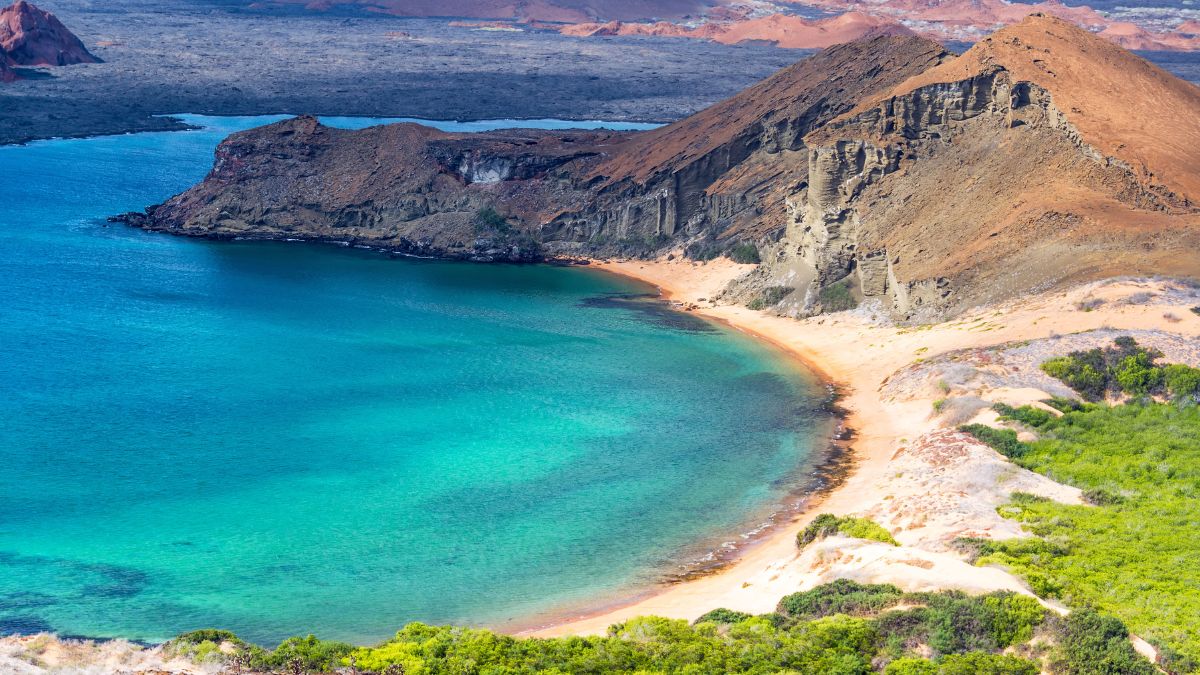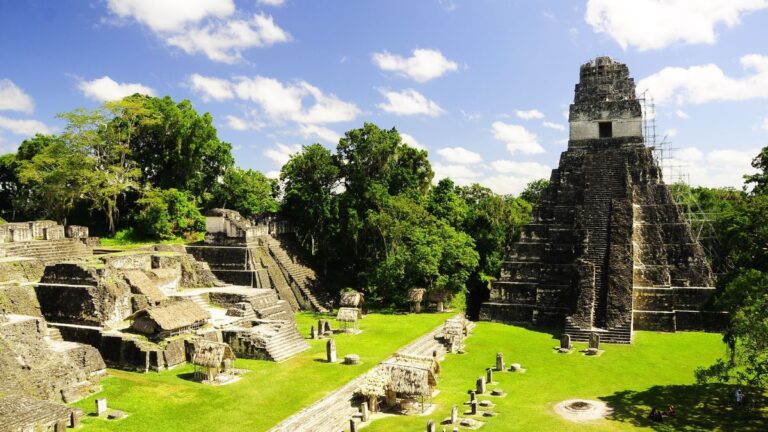Worst Time to Visit Galapagos: How Seasonal Changes Impact Wildlife Encounters

As participants in Amazon Associates and other programs, we earn from qualifying purchases. This comes at no additional cost to you. For more details, see our Affiliate Disclosure.
The Galapagos Islands are a tapestry of unique wildlife and breathtaking landscapes that attract thousands of visitors each year. But just as the archipelago is known for its unparalleled biodiversity, the islands also experience distinct seasonal changes that can influence your wildlife encounters. Knowing the worst time to visit the Galapagos can help ensure your trip doesn’t fall short of expectations.
HIGHLIGHTS
- Peak tourist seasons in the Galapagos, namely June to September and mid-December to mid-January, coincide with higher prices and potential overcrowding but offer a bustling atmosphere and full-swing activities.
- Off-peak seasons present unique challenges such as unpredictable weather and variable diving conditions but also provide opportunities for a more intimate and budget-friendly experience.
- Invasive species like blackberry, invasive rats, and the Philornis downsi fly pose significant threats to native Galapagos wildlife due to human-introduced disruptions.
Understanding the Galapagos Climate: Wet vs. Dry Season
Nestled on the equator, the Galapagos Islands are subject to a unique climate influenced by ocean currents, altitude variations, and their position in relation to the South American continent. Fundamentally, the archipelago has two main seasons: the wet and the dry.
Wet Season (December to May)
Typically, the wet season is warmer, with occasional short but heavy rain showers, especially during the afternoon. Despite the name, this season offers plenty of sunshine, and the seas are calmer and warmer, making it ideal for snorkeling and diving.
The warmer waters bring an influx of marine species. Land birds begin their nesting, and the vibrant flora starts to bloom, painting the islands in various hues of green.
Dry Season (June to November)
Contrary to the wet season, the dry season is cooler with misty, overcast skies, particularly in the highlands. The Humboldt Current makes its presence known, causing chillier waters and rougher seas.
Despite its name, the dry season is a period of great activity. The cold waters are rich in nutrients, attracting a plethora of marine life. This is the season where you can witness the incredible mating dance of the blue-footed booby or see the magnificent humpback whales pass by the islands.
In choosing between the two, it’s essential to understand that neither season can be labeled as the definitive “worst” time to visit. Both have their advantages and unique offerings. What’s more crucial is aligning your personal interests with what each season presents, whether it’s warm beach days or the fascinating behaviors of mating birds.
Wildlife Migrations: When and Why Species Move
Migration is nature’s magical phenomenon, a testimony to the tenacity and adaptability of various species. In the Galapagos, due to its isolated nature and distinct ecosystems, migrations are not as pronounced as in larger land masses. However, the shifts in water temperatures and food availability due to seasonal changes prompt certain species to make significant movements.
1. Seabirds in Motion
Waved Albatross: Exclusively breeding on Española Island, they arrive in April and stay until December. Their remarkable dance rituals and nesting behaviors are a sight to behold during this period.
Red-footed and Blue-footed Boobies: While they can be seen throughout the year, their breeding and nesting activities are highly influenced by the availability of food, making their patterns less predictable.
2. Marine Life On the Move
Hammerhead Sharks: Schools of scalloped hammerheads are more commonly observed between December and May when the waters are warmer.
Manta Rays: They frequent the archipelago around the same period, attracted by the plankton-rich warmer waters.
3. Terrestrial Species Transitions
Giant Tortoises: Between June and December, these ancient reptiles migrate from the highlands down to the coastal areas for nesting. Their slow, deliberate journeys are a testament to the enduring rhythms of nature.
4. The Elusive Whale Migration
Humpback Whales: Between June and September, the cooler waters, rich in nutrients, attract these majestic creatures as they pass by the islands during their long migratory routes.
Understanding these migrations is essential for travelers looking to witness specific wildlife spectacles. While it’s true that the Galapagos teem with life all year round, aligning your visit with these natural movements ensures a richer, more immersive experience.
And while migrations ensure survival for these species, they offer visitors a glimpse into the delicate balance and intricate choreography of nature.
Sea Temperatures and Marine Life: When the Waters Aren’t Welcoming
The Galapagos archipelago is a marine wonderland, boasting a diverse range of marine life due to its unique position at the confluence of several major oceanic currents. The fluctuating sea temperatures play a pivotal role in determining the kind of marine species one might encounter during a visit. However, the colder waters might not always seem inviting to the human visitor, even if they’re teeming with wildlife.
1. The Cool Influence of the Humboldt Current
When: Predominantly affecting the islands between June and November.
Effects: Originating from the southern tip of South America, the Humboldt Current sweeps up the western coast, bringing cold water rich in nutrients. This results in chillier sea temperatures, sometimes dropping to 18°C (64°F).
Wildlife Bounty: The nutrient-rich waters are a magnet for a range of marine species, including various sharks, rays, and fish. It also leads to an upsurge in plankton, the primary food source for many marine animals.
2. The Warm Phase: El Niño
When: Occurs irregularly, but when it does, it’s typically between December and May.
Effects: El Niño brings warmer sea temperatures, often reaching up to 25°C (77°F), and can lead to increased rainfall and occasionally disrupt the normal marine ecosystems.
Wildlife Disruptions: Warmer waters can sometimes reduce the nutrient levels, affecting the food chain. This might lead to a decrease in certain marine species, while others, more accustomed to warmer waters, might become more prevalent.
3. The Human Consideration
Snorkeling and Diving: While the cooler waters from June to November are rich in marine life, visitors might find the need for thicker wetsuits. Conversely, the warmer season offers more comfortable water temperatures, but with slightly reduced visibility due to plankton blooms.
4. The Balance of Nature
While cooler waters might seem less welcoming to the casual swimmer or snorkeler, they are a paradise for marine enthusiasts looking to witness the richness of marine biodiversity. Conversely, those seeking more leisurely water activities might prefer the warmth and calm of the wet season.
While the Galapagos waters are always filled with marine wonders, one’s personal preferences regarding water temperature and specific marine encounters play a significant role in determining the “welcoming” nature of the seas.
Breeding Seasons: The Absence and Presence of Iconic Species
The Galapagos Islands, often referred to as a living laboratory of evolution, offer one of the most intimate wildlife experiences on the planet. The breeding seasons, in particular, are nature’s spectacle, providing a unique opportunity to observe the rituals, behaviors, and nurturing instincts of various species. But, just as these periods bring forth the presence of some iconic species, they also mark the absence of others, as they venture off to quieter or more suitable breeding grounds.
1. Land Birds Taking Center Stage
Galapagos Finches: These iconic birds, pivotal to Darwin’s theory of evolution, have breeding seasons that can vary depending on environmental conditions, but most breed between January and March when the conditions are wetter and food is abundant.
Galapagos Hawks: Their breeding season typically spans from August to October.
2. Seabird Spectacles
Blue-footed Boobies: They engage in their mesmerizing mating dance mostly between June and August, but this can vary based on food availability.
Flightless Cormorants: Native to Isabela and Fernandina islands, their breeding peaks between May and October.
Galapagos Penguins: Unique as the only penguin species found north of the equator, their breeding is closely tied to food availability, but peaks often occur between May and January.
3. Marine Marvels and Their Offspring
Green Sea Turtles: These graceful creatures come ashore to lay their eggs primarily between December and June. Hatchlings can be seen making their perilous journey to the sea between April and May.
Galapagos Sea Lions: Pups are commonly born between August and November, making for adorable sightings as they play in shallow waters under the watchful eyes of their mothers.
4. Land Giants and Their Young
Giant Tortoises: Breeding generally occurs between June and December, with eggs laid soon after. The incubation period varies, but visitors between December and April might be lucky enough to witness the emergence of young tortoises from their nests.
In planning a visit to the Galapagos, travelers should consider the unique breeding timelines of their most sought-after species. While the archipelago never truly sleeps and always has some form of wildlife activity, aligning your trip with these natural rhythms ensures a deeper connection and a heightened sense of wonder.
Tourism Peaks: The Double-Edged Sword of Popularity
The Galapagos Islands, a UNESCO World Heritage site, attract travelers from around the globe, drawn by the promise of unparalleled wildlife encounters. Yet, this popularity comes with its challenges.
Peak tourist seasons in the Galapagos generally coincide with major holiday periods. The months of June to September and mid-December to mid-January see the most influx, thanks to summer vacations and festive breaks. During these times, the islands brim with tourists, leading to a bustling atmosphere.
The heightened footfall has its advantages. Many guided tours, cruises, and activities are in full swing, offering a myriad of choices to explore the archipelago. Local businesses, from restaurants to souvenir shops, thrive, making it a great time for travelers seeking both nature and conveniences.
However, this popularity is a double-edged sword. The increased number of visitors can sometimes disrupt the serene nature of the islands. Popular sites might feel crowded, potentially diminishing the intimate wildlife experiences the Galapagos are famed for.
Additionally, accommodation and tour prices often spike, and availability becomes scarce, necessitating early bookings.
The environmental impact of tourism is also a concern. The Galapagos ecosystem is delicate, and increased human activity can strain its resources and potentially disturb its habitats.
Strict regulations are in place to mitigate this, but responsible tourism practices by each visitor become even more crucial during peak periods.
Invasive Species: Seasonal Pests and Their Effect on Native Wildlife
The unique biodiversity of the Galapagos Islands, shaped over millennia in relative isolation, now faces threats from invasive species, many of which were inadvertently introduced by humans. These foreign species, from plants to rodents, disrupt the native ecosystems, causing significant challenges for indigenous flora and fauna.
- Blackberry: Introduced as a food plant, it’s now rampant in the highlands, forming dense thickets that restrict the movement of native species, such as the Galapagos tortoise, and smothering indigenous plants.
- Invasive Rats: Arriving on ships, these rodents have become predators, feasting on the eggs and chicks of native birds and causing a decline in bird populations across various islands.
- Philornis Downsi Fly: Native to Trinidad and mainland South America, the larvae of this fly are parasitic, feeding on the blood of baby birds. This has led to significant mortality rates, especially among the Galapagos finch.
- Tourism & Seasonal Vessel Movement: Increased human activity and ship movement can risk further introductions of invasive species. While biosecurity measures are stricter now, the challenge remains in managing and mitigating the effects of already established invaders.
Promoting awareness and understanding of these threats is vital. Only through collective and informed efforts can the pristine nature of the Galapagos be preserved for future generations.
Practical Considerations: Costs, Availability, and Other Seasonal Factors
When planning a trip to the Galapagos Islands, understanding the seasonal dynamics is crucial. Not only do these factors influence wildlife sightings, but they also affect practical considerations such as costs, availability, and overall experience. Here’s a rundown of what potential visitors should keep in mind:
Cost Implications
Peak Seasons: During the busiest months of June to September and mid-December to mid-January, expect higher prices on accommodations, tours, and flights due to increased demand.
Off-Peak Discounts: Traveling during the off-peak seasons may offer potential savings, as some operators might offer discounted rates to attract visitors.
Accommodation and Tour Availability
Book Early for Peak Times: With a surge in tourists during the peak months, popular hotels, cruises, and tours can get booked out months in advance.
Last-Minute Options: During less busy months, there might be more flexibility for last-minute bookings, and travelers might have a wider range of options to choose from.
Weather and Equipment
Wet vs. Dry Season: The Galapagos has two main seasons. The warm, wet season from December to June can be more unpredictable, with sporadic rain showers, but the sea is calmer and warmer for snorkeling. The dry season from July to November is cooler and can be windier, with choppier seas, making it essential to pack accordingly.
Diving Considerations: Water visibility can change seasonally, which might affect divers’ preferences on when to visit. Also, water temperatures can fluctuate, requiring different wetsuit thicknesses.
Visitor Site Regulations
Restricted Access: To protect the ecosystem and avoid overcrowding, some visitor sites have limits on the number of visitors or might be closed at certain times. Researching in advance or consulting with tour operators can help in planning.
Local Events and Festivities
Galapagos Celebrations: There are certain times of the year when local festivals or events occur, providing a unique cultural addition to the natural attractions. However, these can also influence accommodation availability and prices.
Considering these practical factors in tandem with wildlife patterns and personal preferences ensures a smoother, more fulfilling Galapagos experience. With a bit of planning and research, travelers can strike the right balance between cost, availability, and the wonders of the islands.
Planning for the Best: Tips to Sidestep the Off-Peak Pitfalls
The allure of the Galapagos Islands remains consistent year-round, but savvy travelers know that avoiding peak seasons can lead to a more serene and budget-friendly experience. However, the off-peak months, with their own set of challenges, require thoughtful planning. Here are some tips to navigate the potential pitfalls and ensure a memorable Galapagos journey:
1. Research and Reserve: While off-peak often means fewer tourists, it doesn’t always translate to abundant availability. Some operators might reduce the number of tours or accommodations could be under maintenance. It’s prudent to book essential experiences and stays in advance.
2. Pack for Variability: Weather during the off-peak season can be unpredictable. Packing layered clothing, a sturdy rain jacket, and waterproof bags can help you remain comfortable and prepared for sudden showers or temperature drops.
3. Dive with Caution: If diving or snorkeling is a priority, be aware that water visibility can change, and currents might be stronger. Always consult with local dive operators about conditions and consider investing in a thicker wetsuit for cooler waters.
4. Stay Flexible: The beauty of fewer tourists can mean more flexibility in your itinerary. Be open to changing plans based on local recommendations, weather conditions, or sudden openings in tours or activities.
5. Embrace the Quiet: Fewer visitors mean you’ll have a more intimate and peaceful experience. Take advantage of the tranquility by visiting popular sites, knowing they’ll be less crowded, or simply soaking in the natural beauty with fewer distractions.
6. Engage with Locals: With fewer tourists around, it’s an excellent time to engage more deeply with local guides, operators, and residents. Their insights can enhance your understanding of the islands and lead to more authentic experiences.
7. Monitor Flight Schedules: During off-peak periods, flight schedules to and from the Galapagos might be reduced. Always double-check flight timings and consider arriving a day early to ensure you don’t miss any booked tours.
8. Support Conservation Efforts: With fewer tourists, there might be more opportunities to participate in local conservation efforts or eco-tourism projects. This not only enriches your experience but also helps the islands’ ecosystems.
9. Prepare for Wildlife Nuances: While the Galapagos is teeming with wildlife year-round, certain species might be less visible during off-peak months. Research the wildlife patterns for the specific time of your visit to manage expectations.
10. Budget Wisely: The off-peak season might offer discounts, but it’s essential to budget for unexpected expenses, especially if weather conditions change plans or if specific activities require additional equipment.
In essence, a trip to the Galapagos during off-peak times can be just as magical, if not more so, than during peak tourist periods. With proper planning, an open mind, and flexibility, travelers can sidestep potential pitfalls and craft a uniquely fulfilling island experience.






